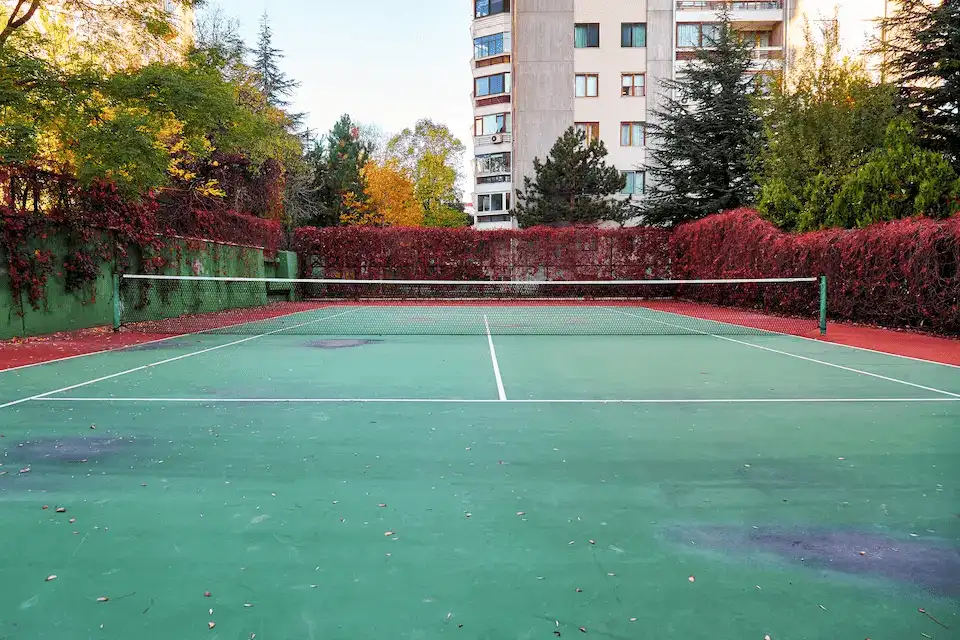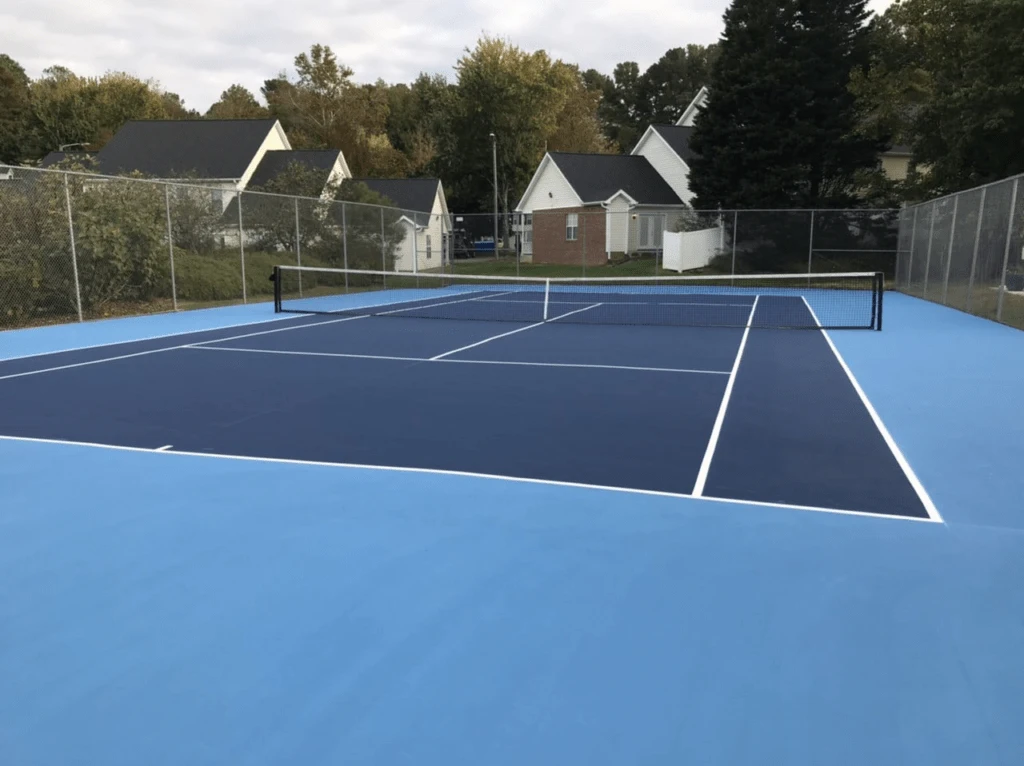
If you want to play your best tennis game possible, regular maintenance is necessary for your court. If you don’t take steps to keep your court conditions optimal, you’ll not only ruin your court but also not have the best playing conditions. Who wants that?
Maintaining your tennis court is easy if you keep up with it. By keeping the playing surface in the best condition possible, you’re getting the most out of your investment.
North State Resurfacing, a Raleigh tennis court contractor, is committed to helping tennis court owners keep up with their maintenance so that their courts are always in the best playing condition possible. We’re going to share some tennis court maintenance tips that can help you achieve desired playing conditions every time you hit the court.
Why Tennis Court Maintenance is Important
Appearance
Keeping your tennis court surface in good shape can add value to your property and present a good impression.
Safety
When your tennis court is properly maintained it will be even and safe to play on and have the proper traction. If it’s not, players can twist an ankle, slip, or trip while playing.
Longevity
Regular maintenance will help you to have your courts around for a longer time. Simple things like removing standing water can go a long way when it comes to court longevity. When standing water and debris are not attended to, they can cause cracks, soft spots, and extensive damage. Regularly removing water and sweeping your court can also help to avoid mold and mildew accumulation.
If you are maintaining your court, you’ll also be able to spot any issues as they occur, rather than when they have caused more costly damage.
Performance
Well-maintained courts lead to better performance. The better the playing conditions, the better the game.

General Tennis Court Maintenance Tips
Keeping up with tennis court maintenance is easy no matter what type of tennis court surface you have. Following these simple tips can go a long way.
Remove Standing Water
Dirt can accumulate when there is standing water on tennis courts. This leads to stains and piles of debris. When these materials are on the court, it creates an abrasion on the tennis court surface. If you notice standing water on your court, remove it as soon as possible to avoid any issues.
Clean Your Court Regularly
Cleaning your court monthly is often recommended to prevent the growth of mold or mildew and to get rid of other debris. Many people underestimate how important it is to keep your court clean.
Remove Leaves
Leaves and pine needles will stain your tennis court and can lead to mold and mildew. Remove them regularly to avoid this from happening.
Remove Snow & Ice
If you live in a climate where snow and ice can form on your tennis court surface, you’ll want to remove them carefully. Using hard or sharp tools is not recommended because they can damage surface coatings. Snow or ice melt is also not recommended because the chemicals can damage the surface. You want to be careful if a snowplow is clearing the snow because direct contact of the blades and the tennis court surface could lead to costly damage.
Monitor Drainage Channels
Look around your court for any evidence of damage to drainage structures and drainpipes. Clear any vegetation or debris that may be blocking them. If there are any blockages, your court will not drain properly, and water can get under the playing surface.
Landscape Maintenance
While you want to keep your tennis court maintained, you also want to make sure any surrounding landscaping is also being taken care of. Always keep grass and other vegetation around the court surface trimmed. You can minimize the amount of dirt and debris that may get on your court by mulching plant beds and planting grass on any bare areas around the facility. Be careful not to over-water vegetation around the court. This can lead to excess moisture beneath the surface base.
Tennis Court Maintenance by Surface Type
Now that we have some basic tennis court maintenance tips, it’s time to look at how specific tennis court surfaces should be maintained. Some surfaces need special care due to the materials used.
Asphalt Tennis Court Maintenance
Regularly remove debris, leaves, dust, and grass from asphalt surfaces. This will help to avoid premature deterioration.
Use a mild detergent solution and water rather than a high-pressure washer on your hard surface court. Using a pressure washer can cause damage.
Fix any cracks in the court’s surface as soon as you notice them. This will not only allow your court to last longer but also help to avoid more costly repairs.
Caulk and seal any court expansion joints so that water won’t penetrate below the slab.
If you notice structural problems, such as foundation settlement, it may be best to have the court redone. The professionals at North State Resurfacing can help you determine if this is the best route to take.
Har-Tru or Clay Tennis Court Maintenance
If you have a Har-Tru or clay court, a daily maintenance brush is a good idea. Use a sweeping brush rather than a broom with hard bristles that could damage the surface.
Water the court to keep it stable and firm. It’s often recommended to water a clay tennis court twice daily. But if it already seems moist enough you may not have to do it that frequently.
For periodic maintenance, you’ll want to fill in low spots and divots and any court surface areas that are too high. You can address any drainage issues by fixing slippery areas.
Annual maintenance includes fully cleaning and leveling the court, and installing fresh, slip-resistant tape. During an annual inspection, be sure to look at whether it may be time to apply a new top dressing material. You want to make sure the court has the proper traction and is in top shape at all times.
Grass Court Maintenance
A grass court surface is more high maintenance than a clay tennis court or asphalt tennis court. You’ll want to follow these maintenance tips:
Mow every 2-3 days to maintain a grass length of between 1/4 and 1/3 of an inch.
Water after each use.
Be sure the grass is fertilized well. Brown or dry grass can be slippery and cause a safety hazard.
Following these maintenance tips for tennis courts can ensure that you are keeping on top of any court changes and will have the safest and smoothest playing surface.
FAQ about Tennis Court Maintenance
How will I know when tennis court resurfacing is necessary?
Reappearing cracks, large pools of water, and a bubbling surface are all indications that tennis court resurfacing is needed. No matter how well you maintain your court, you will have to resurface your court at some point.
What should I do if I notice water penetration on the court surface?
You may have a drainage issue. Check your drainage channels for any blockages. If you don’t notice an issue, it’s best to call a professional to assess the problem.
How often do synthetic grass courts need maintenance?
This will depend on factors like the type of synthetic grass, the shade and debris from trees, and how much the court is used.
Count on North State Resurfacing for all of Your Tennis Court Maintenance Needs
North State Resurfacing can take care of all your tennis court maintenance needs. We can regularly inspect your tennis court to ensure that it will provide optimal performance. Our team of professionals can also let you know when you may want to think about tennis court resurfacing.
We are also your source for any new tennis court construction and tennis court accessories that you may need. Call North State Resurfacing today at (919) 365-7500 to learn more!
